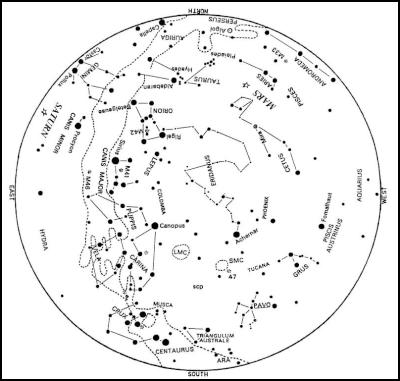The January Night Sky
The National Observatory of New Zealand
The Night Sky
Brian Carter
THE JANUARY NIGHT
SKY
Towards the end of the month we will start to see the days getting shorter and, therefore, the nights for astronomy, longer.
Planets
January is a fairly good month for viewing the planets. Mars, Jupiter and Saturn will be visible for the whole of the month. Venus will be visible in the evening sky at the start of January and in the morning towards the end of the month. Mercury will be visible in the morning sky at the start of the month.
Venus can be seen in the evening twilight sky for the first few days and in the morning sky for the last few days of January. At the start of the month it sets at 21:53 and by January 9 it sets at the same time as the Sun, at 21:00. By January 17 it rises as the Sun rises at 06:08 and by the end of the month it rises at 04:50. Venus is in the constellation of Sagittarius. It starts the month at magnitude –4.4, fading to –4.1 by January 13, then brightens to –4.5 by month’s end.
Saturn will be visible for all of the night except for the early evening at the start of the month. At the start of January it rises at 22:32 and by January 26 it rises as the Sun sets at 20:48. Saturn is in the constellation of Cancer, in which it remains until September 2006. Its magnitude slightly brightens from –0.1 to –0.2, it’s brightest for the year.
Mars will be visible for the first half of the night. At the start of the night it sets at 02:15 and at 00:46 by month’s end. Mars is in the constellation of Aries, in which it remains until 2006 February. Its magnitude fades from –0.6, it’s brightest for the year, to 0.2 by month’s end.
Jupiter will be visible for the last half of the night. At the start of the month it rises at 02:28 and by month’s end at 00:42. Jupiter is in the constellation of Libra, in which it remains until December 2006. Its magnitude slightly increases from –1.8 to –2.0 during the month.
Mercury will be visible in the morning twilight for the first half of January. At the start of the month it rises at 04:46, by January 7 at 04:59 (an hour before Sunrise) and by January 28 it rises at Sunrise. Mercury starts the month in the constellation of Ophiuchus, moving into Sagittarius on January 2 and finally into Capricornus on January 23. Its magnitude rises from –0.5 to –1.0 by January 20.
All times are for Wellington unless otherwise stated. Other centres may vary by a few minutes.
Phases of the Moon
First Quarter –
January 7 at 07:56.
Full Moon – January 14 at
22:48.
Last Quarter – January 23 at 04:14.
New Moon –
January 30 at 03:15.
Earth at Perihelion
The Earth is at perihelion (closest to the Sun) at 04:00 on January 5. The distance is 0.9833270 AU, which is 147,103,600 km.
Diary of Astronomical Phenomena
Jan 2 Moon at perigee (closest to the Earth)
at 12:00. (Distance = 0.0024182 AU = 361,760 km).
5 Earth
at perihelion (closest to the Sun) at 04:00. (Distance =
0.9833270 AU = 147,103,600 km).
14 Venus in inferior
conjunction (between the Sun and the Earth) at
13:00.
14 Full Moon at 22:48.
16 Saturn 4S of
Moon at 02:00.
18 Moon at apogee (furthest from the
Earth) at 08:00 (Distance = 0.0027132 AU = 405,890
km).
26 Antares close to the Moon as they rise at ~01:50.
Antares (alpha Scorpius) is a red supergiant at a distance
of ~400 light years.
27 Mercury in superior conjunction
(on the far side of the Sun) at 11:00.
28 Saturn at
opposition (on the opposite side of the Earth to the Sun) at
12:00.
30 New Moon at 03:15.
30 Moon at perigee
(closest to the Earth) at 21:00. (Distance = 0.0023916 AU =
357,780 km).
JANUARY SKY CHART
This chart shows the sky as it appears at about 22:00 for January.

Click for big version
How To Use the Sky Charts
To use the sky chart hold it up to the sky so that the direction in which you are looking is at the lower edge of the map. For example, if you are looking at the western horizon then the map should be held so that the “WEST” label is at the lower edge. The altitude and direction of the stars and planets will then be correctly shown. The centre of the chart will be directly overhead.
Brian Carter is the Senior Astronomer at Carter Observatory (The National Observatory of New Zealand), PO Box 2909, Wellington. (Observatory Web Site: www.CarterObservatory.org )


 Eugene Doyle: The Fall Of Saigon 1975 - Fifty Years Of Repeating What Was Forgotten
Eugene Doyle: The Fall Of Saigon 1975 - Fifty Years Of Repeating What Was Forgotten Peter Dunne: Dunne's Weekly - Trump's Tariffs Still Pose Risks For New Zealand
Peter Dunne: Dunne's Weekly - Trump's Tariffs Still Pose Risks For New Zealand Keith Rankin: Barbecued Hamburgers And Churchill's Bestie
Keith Rankin: Barbecued Hamburgers And Churchill's Bestie Gordon Campbell: On Why The US Stands To Lose The Tariff Wars
Gordon Campbell: On Why The US Stands To Lose The Tariff Wars Eugene Doyle: Before It’s Too Late - Reimagine New Zealand’s Military Future
Eugene Doyle: Before It’s Too Late - Reimagine New Zealand’s Military Future  Binoy Kampmark: Gender Stunts In Space - Blue Origin’s Female Celebrity Envoys
Binoy Kampmark: Gender Stunts In Space - Blue Origin’s Female Celebrity Envoys